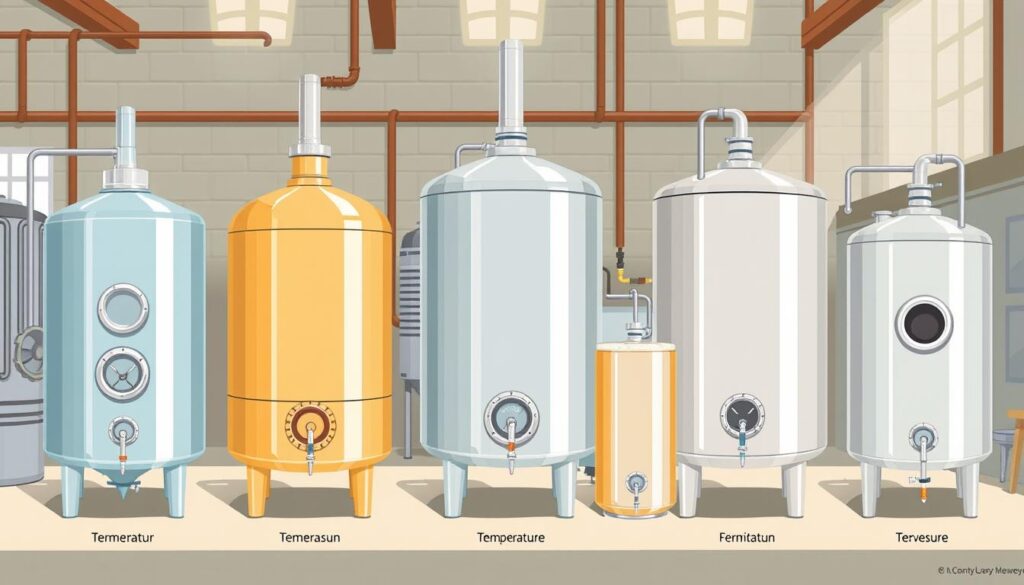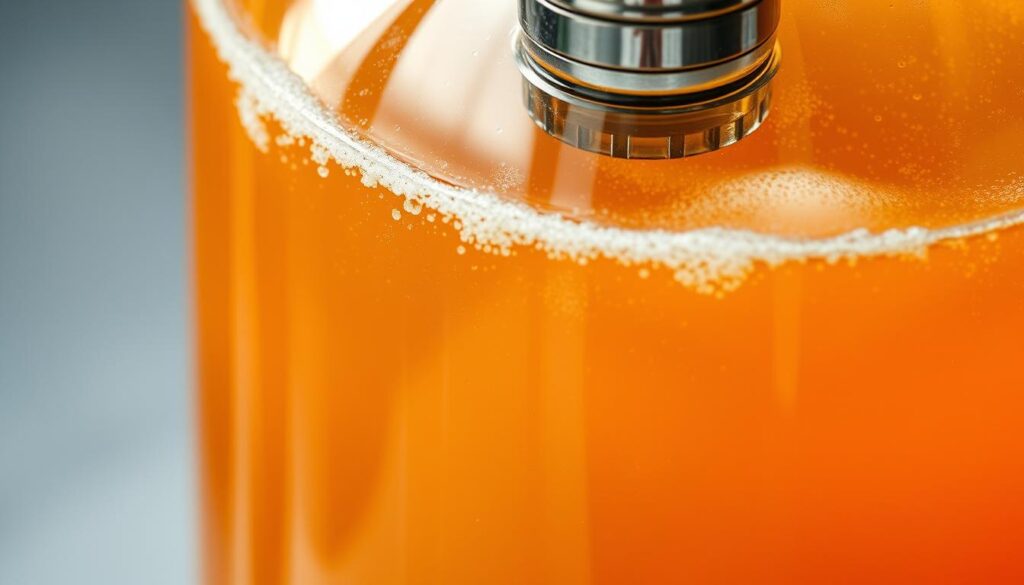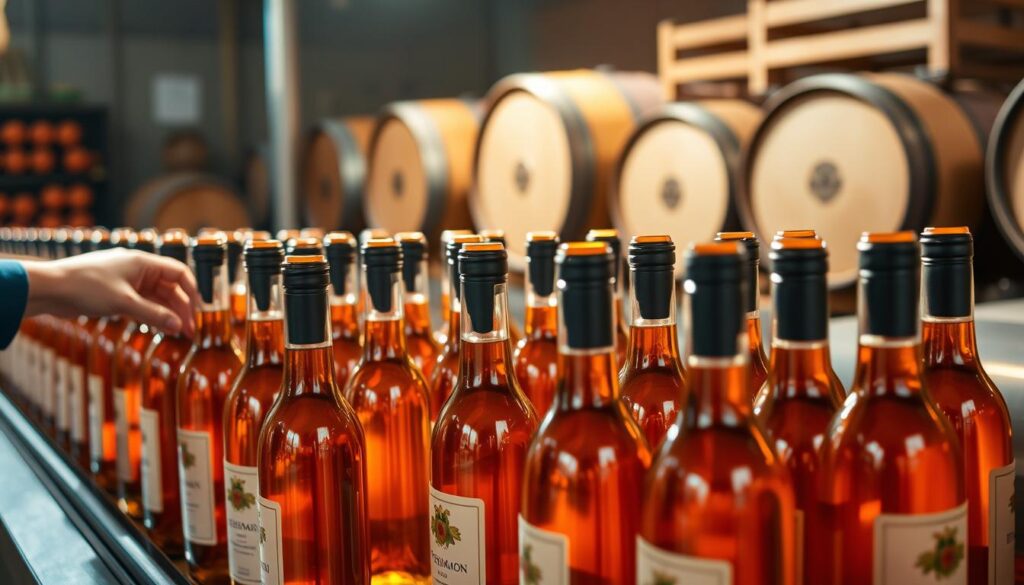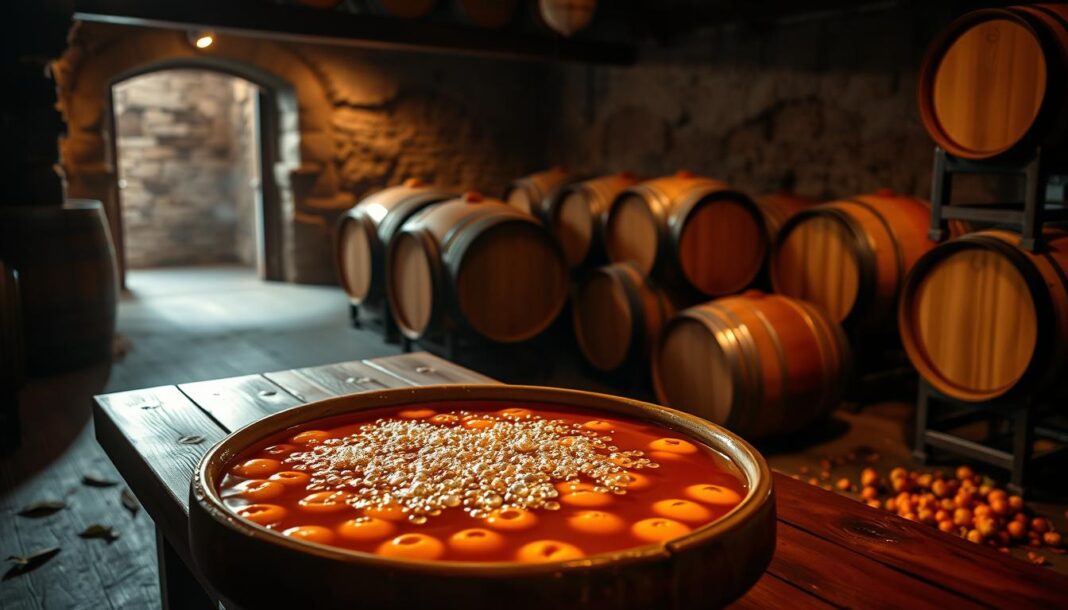Making persimmon wine is a rewarding experience that requires patience and attention to detail. When fully ripe, persimmons are one of the sweetest fruits, making them ideal for creating a delicious and unique homemade wine.
With good quality persimmons, you can produce a fine, fruity wine at home in under six months. The process involves careful selection of the fruit, managing the fermentation process, and allowing the wine to age properly.
We will guide you through each stage, from selecting the right fruit varieties to bottling your finished product, ensuring that you create a wine that showcases the distinctive flavor profile of persimmons.
Key Takeaways
- Learn how to transform sweet, ripe persimmons into a delicious homemade wine.
- Understand the science behind successful fermentation and yeast activity.
- Discover why persimmon wine has become popular among home winemakers.
- Follow our guide to create a fruit wine that balances sweetness, acidity, and alcohol content.
- Understand the importance of patience in persimmon winemaking and proper aging.
Understanding Persimmons for Winemaking
The journey to making outstanding persimmon wine begins with understanding the intricacies of persimmons. Persimmons are one of the very last fruits of the year, ripening in November and December, making them an ideal candidate for a final winemaking project before the new year.
Types of Persimmons Suitable for Wine
Not all persimmons are created equal when it comes to winemaking. The two most commonly used varieties are Fuyu and Hachiya.
Fuyu (Sweet) Persimmons
Fuyu persimmons are sweet and can be used when they’ve developed their full sugar content but still retain some firmness, making them easier to process.
Hachiya Persimmons
Hachiya persimmons, on the other hand, need to be completely soft and jelly-like. This ripeness is crucial for breaking down tannins, which is essential for a smooth wine.
When Persimmons Are Ready for Wine
The ripeness of persimmons is critical for winemaking. For Hachiya, this means waiting until they’re completely soft. For Fuyu, it’s about achieving full sugar content while maintaining some structural integrity. Understanding the relationship between ripeness, sugar content, and potential alcohol development is key to planning your fermentation process. The time of persimmon harvest, typically November-December, affects your winemaking calendar. By waiting for the optimal ripeness, you ensure a high-quality wine with the desired alcohol content.
Essential Equipment for Persimmon Wine
Making persimmon wine requires a thoughtful selection of equipment to ensure a high-quality outcome. The right tools not only simplify the process but also significantly impact the final product’s flavor and overall character.

Primary Fermentation Vessels
The primary fermentation vessel is where the initial fermentation process takes place. We recommend using a food-grade plastic bucket or a glass carboy. These vessels are ideal because they are easy to clean and allow for the necessary oxygen exchange during the initial fermentation phase.
Key considerations include the vessel’s size, material, and the presence of an airlock to manage fermentation gases.
Secondary Fermentation Equipment
After the initial fermentation, the wine is transferred to a secondary fermentation vessel, typically a glass carboy, to continue the fermentation and clarification process. This stage is crucial for developing the wine’s clarity and flavor profile.
The use of an airlock is essential to prevent contamination and allow CO2 to escape.
Bottling Supplies
Once the persimmon wine has completed its fermentation and clarification, it’s time to bottle. For small batch recipes, we recommend using flip-top Grolsch-style bottles, which provide an excellent seal without requiring a corking setup. For larger batches or longer aging periods, traditional wine bottles and corresponding corking equipment are recommended.
Proper sanitization of all bottling equipment is crucial to prevent spoilage. We outline effective sanitization procedures using specialized brewing sanitizers.
Using amber or green glass bottles can protect your wine from light damage during storage. Additionally, bottling siphons, tube clamps, and bottle fillers make the process cleaner and more efficient.
Ingredients for Perfect Persimmon Wine

To produce a high-quality persimmon wine, it’s crucial to start with the right ingredients. The quality and type of ingredients you choose will significantly impact the flavor, clarity, and overall character of your wine.
Basic Ingredients List
The basic ingredients for making persimmon wine include persimmons, sugar, water, and wine yeast suitable for fruit wines. The quality of these ingredients is paramount; for instance, choosing ripe and healthy persimmons will directly affect the wine’s flavor profile.
Understanding Wine Additives
Several additives can enhance your persimmon wine’s quality. Understanding their roles is crucial for a successful brew.
Pectic Enzyme
Pectic enzyme breaks down the cell walls of persimmons, releasing more juice and preventing pectin haze in your finished wine. This is particularly important with starchy fruits like persimmons.
Acid Blend
An acid blend adjusts the pH levels in your wine, affecting both flavor balance and fermentation health. Persimmons often require additional acid to achieve proper balance.
Yeast Nutrient
Yeast nutrient provides essential micronutrients that may be lacking in fruit wines, ensuring your yeast can complete fermentation without producing off-flavors from stress.
Wine Stabilizers
Wine stabilizers like potassium sorbate prevent refermentation in bottles if you choose to sweeten your finished wine. For more detailed information on making persimmon wine, you can visit this resource.
Step-by-Step Persimmon Wine Making Process
Now that we have our persimmons and equipment ready, let’s dive into the step-by-step process of making persimmon wine. This process involves several key stages that require attention to detail and patience.
Preparing Your Persimmons
The first step in making persimmon wine is preparing the persimmons. This involves washing, crushing, and mixing them with water and other ingredients to create a pulp. The pulp is then left to ferment, releasing the flavors and colors into the wine.
Primary Fermentation
Primary fermentation is a critical stage where the natural yeast and sugars in the persimmon pulp start to convert into alcohol. We need to monitor the fermentation temperature and specific gravity to ensure that the wine is developing the desired characteristics.
During this stage, it’s essential to keep the fermentation vessel covered to prevent contamination and oxidation. We recommend using an airlock to allow CO2 to escape while keeping air out.
Secondary Fermentation
After the primary fermentation is complete, the wine is transferred to a secondary fermentation vessel for further clarification and maturation. This stage is crucial for developing the complex flavors and clarity of the wine.
Secondary fermentation typically takes longer than primary fermentation, and it’s essential to be patient and monitor the wine’s progress regularly.
Racking and Clearing
Racking involves transferring the wine from one vessel to another, leaving behind the sediment. This process helps to clarify and stabilize the wine, improving its overall quality.
- We’ll explain the racking process in detail, showing how to properly transfer your persimmon wine while leaving sediment behind to improve clarity and flavor.
- Multiple racking sessions are typically necessary for fruit wines like persimmon – we’ll recommend an optimal schedule based on sediment formation.
- For persistent cloudiness, we’ll explain the proper use of clearing agents like bentonite, isinglass, or commercial wine clarifiers specifically suited to fruit wines.
Once the wine has cleared completely, siphon it off of the sediment again. Stir in 5 Campden Tables that have been crushed and then bottle. When siphoning off the sediment, unlike the first time you siphoned the wine, you want to leave all of the sediment behind, even if you lose a little wine.
Troubleshooting Common Persimmon Wine Issues
As you embark on your persimmon wine making journey, you may encounter some common issues that can be easily resolved with the right troubleshooting techniques. Ensuring the quality of your wine is paramount, and addressing these issues promptly can make all the difference.

Cloudy Wine Solutions
One common issue with persimmon wine is cloudiness, which can result from inadequate fermentation or poor handling of the juice. To address this, ensure that your equipment is properly sanitized, and consider using a fining agent to clarify your wine. Additionally, allowing your wine to age properly can help it clear naturally.
Fermentation Problems
Fermentation issues can arise due to factors such as temperature fluctuations, inadequate yeast nutrition, or contamination. To avoid stuck fermentation, maintain a stable temperature between 70-75°F and ensure your yeast has the necessary nutrients. Monitoring your fermentation closely and being prepared to intervene if necessary can help prevent the production of off-flavors or alcohol levels that are too low.
Bottling and Aging Your Persimmon Wine
As we near the completion of our persimmon wine making journey, it’s time to focus on the crucial steps of bottling and aging. Proper bottling and storage techniques are essential to preserving the quality and flavor of our homemade persimmon wine.
When to Bottle
The timing of bottling depends on the fermentation process. Generally, we bottle our persimmon wine after it has clarified and stabilized, usually several months after the start of fermentation. For larger batches, one gallon or more, it’s recommended to bottle in wine bottles with corks for better results.

Aging Recommendations
Aging is a critical step that allows the flavors in our persimmon wine to mature and integrate. The aging period can vary, but typically, persimmon wine is aged for at least 6 months to a year. The optimal aging conditions include consistent cool temperatures between 55-65°F and minimal light exposure.
| Aging Factor | Ideal Condition | Impact on Wine |
|---|---|---|
| Temperature | 55-65°F | Consistent cool temperatures allow the wine to age gracefully, preserving its flavor and aroma. |
| Light Exposure | Minimal to None | Light can damage the wine, causing it to become over-oxidized and lose its color and flavor. |
| Humidity | Moderate (around 60-70%) | Proper humidity levels help maintain the integrity of the cork, preventing it from drying out. |
Storage Tips
To ensure our persimmon wine ages well, we must store it under the right conditions. This includes keeping the bottles away from direct sunlight and vibrations, storing them in a cool, dark place, and maintaining a consistent temperature. For wines bottled with corks, storing the bottles on their side can help keep the cork moist.
By following these guidelines, we can enjoy our homemade persimmon wine at its best, savoring the fruits of our labor.
Enjoying Your Homemade Persimmon Wine
The culmination of your efforts in crafting persimmon wine brings us to the most rewarding stage: enjoying the final product. Your homemade persimmon wine is now ready to be savored. To fully appreciate its unique flavor profile, consider the serving temperature, as it significantly impacts the taste.
For a dry persimmon wine, serve at a cooler temperature. If you prefer your wine sweeter, you can add sugar or honey to taste, but first, ensure you add a wine making stabilizer like Potassium Sorbate to prevent re-fermentation. The amount of sugar added depends on personal preference.
Pairing your homemade persimmon wine with the right food can elevate the experience. It complements a variety of cheeses and desserts. When sharing your wine with friends and family, consider the presentation. Use appropriate glassware to showcase the wine’s aromatics, enhancing the overall drinking experience.
As you enjoy your persimmon wine, keep tasting notes to track your preferences and improvements across different batches. For future batches, consider experimenting with variations, such as adding spices or blending with other wines. This will help you refine your winemaking skills and explore new flavors.


